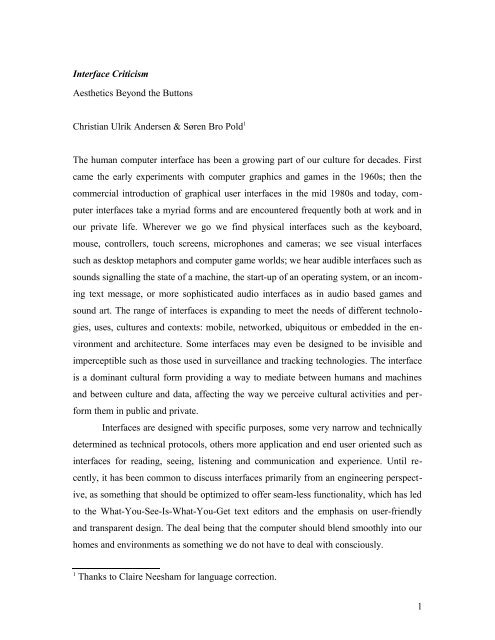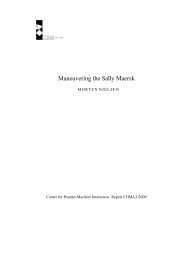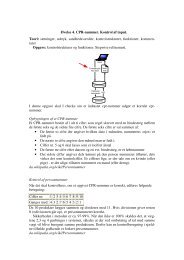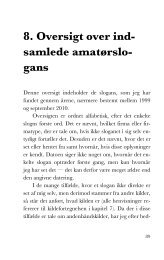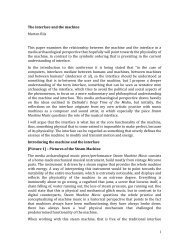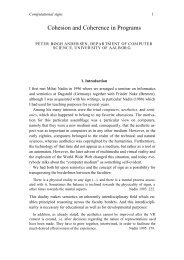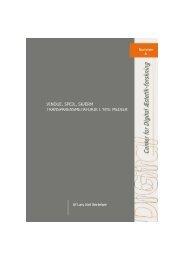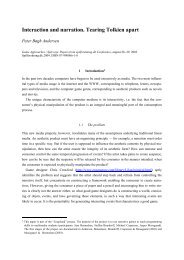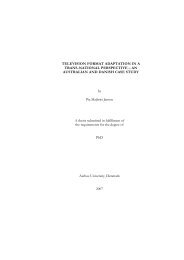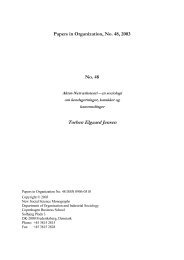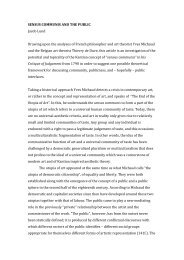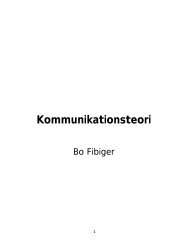introductory chapter - Digital Aesthetics Research Center
introductory chapter - Digital Aesthetics Research Center
introductory chapter - Digital Aesthetics Research Center
Create successful ePaper yourself
Turn your PDF publications into a flip-book with our unique Google optimized e-Paper software.
others are more clearly directed towards human understanding and cultural traditionssuch as interfaces for computer games or digital art. All interfaces, however, are designsthat combine – and translate between – signs and signals. As such, the interface is at thecore of the computer. It is not possible to ‘unveil’ the computer through a deconstructionof the interface. The code behind the interface is just another interface in the layered‘mise en abîme’ architecture of the computer. The functioning of the interface, its designedjuxtaposing of human signs and machine signals, is therefore essential to the functioningof the computer.The question of interface aesthetics is intrinsically linked to our perception of theinterface. If it is not possible to fully ‘unveil’ the ‘mise en abîme’ of the interface we can,however, cast light upon how interfaces can embed choices, conduct, languages, and ultimatelyvalues, worldviews and aesthetics into technical infrastructures. The word aestheticscomes from Aisthesis, which means sense perception, and today we perceive our environmentthrough interfaces. Aesthetic theory consequently needs to develop a criticalvocabulary towards computers and interfaces, an interface criticism, and this book aimsto be one such contribution. An aesthetic aspect of the interface is usually subordinated toa functionalistic dimension (e.g. the use of buttons for actions) or even a stylistic dimension(interfaces may look good or feel good). Conversely, in this book interface aestheticswill be developed as a critical investigation of interfaces, what they mean for – and howthey function in – contemporary culture.Our investigation of the interface does not stop at the computer's surface but goesbeyond the buttons and reaches ‘back’ into history, and ‘through’ to the human sensesand perception, ‘down’ into the machine, ‘out’ into society and culture. This book is consequentlydivided into four sections, that overlap in many ways and often in the articles,but can also be seen as four dimensions in interface aesthetic research: Displays and history,sensation and perception, software and code, culture and politics.Back: Displays and history. The interface is very often a screen through which we canlook into the computer, but this screen is only the preliminary stage of a long and continuoustradition. The book will examine the screen in relation to both the historical developmentof a screen-mediated public sphere and an archaeology of video art and in3
stallations that represent cybernetic activities.Currently, interfaces are spreading into the urban public space as both small portabledevices and big architectural screens. In his “Monumental Attractions: An Archaeologyof Public Media Displays”, Erkki Huhtamo depicts a thought provoking and oftenforgotten prehistory of public media displays. Even in the nineteenth century signboards,billboards, various projection forms as well as an audiovisual extension of the telephonewere used for attracting people’s attention by displaying news and advertisements in thecity landscape. This prehistory not only helps us frame contemporary urban interfaces butalso challenges the visual historian Jonathan Crary’s hypothesis of modern media spectatorshipas an interiorized and privatized mode of experience. Rather than separating theviewer from the surroundings one needs to understand the experience of urban displaysas rooted in a milieu of noises, competing imagery and other distractive elements.While Erkki Huhtamo goes back to the nineteenth century’s public displays, BodilMarie Stavning Thomsen goes back to the nineteen-sixties’ video art scene in order toinvestigate changes in how we perceive and construct the imagery of interfaces. In “TheHaptic Interface – On signal transmissions and events” she explores the history behindthe outspoken use of different forms of haptic imagery in reality TV, direct news broadcasting,and documentary film formats. She argues that Nam June Paik, Les Levine andother video and performance artists experimenting with feed-back and haptic images of‘white noise’ in the 1960s, were the forerunners of a new media immediacy now associatedwith surveillance cameras, web-cams and digital video.Through: sensation and perception. The appearance and cultural diffusion of interfacesaffects the way the world is perceived and sensed. Based on human input, the computerprocesses and presents an output that often is the starting point for new human input intothe computer, and so on. As such, the human-computer interface is an input/output devicewhere humans exist in a symbiosis with the cybernetic system of the computer. In a timewhere our relationship to the world often is dependent on an interface (where the steeringof a car is run by a computer, where knowledge is accessed through a web browser,where play takes place in a computer game, etc.), our sense perception is affected by theinterface. This book will discuss this affect and how it is articulated in contemporary net4
and software art.In the development of and discourses around interfaces there has always been astrong urge to bypass representation and ‘jack’ directly in to the human brain, consciousness,perceptions and feelings. In her article ”The interface at the skin” Lone KoefoedHansen looks at how two contemporary experimental dresses made by Philips within thefield of wearable computing subscribe to the concept of ‘ideal communication’. In herarticle, she explains how this particular type of communication is linked to the paranormalphenomena of mind reading and telepathy, and argues that sensor-based wearablecomputing is the newest example of a technological development implicitly or explicitlyaiming at manifesting two utopian parameters of communication: immediacy and instantaneity.Though utopian, this manifestation has served as a way to brand Philips “as ahighly innovative and remarkable company”.Even though a direct interface to the brain does not exist, the cybernetic symbiosisof man and computer arguably affects human culture. Søren Bro Pold’s article ”InterfacePerception – The Cybernetic Mentality and Its Critics: Ubermorgen.com” presents amodel for a cultural understanding of the cybernetic feedback loop between man andcomputer. Using the example of the artist duo Ubermorgen.com (Lizvlx and HansBernhard), he furthermore discusses how cybernetic loops influence both our culture andnot least our perception and mentality. In their work Ubermorgen.com explore ways tostage a criticism of the cybernetic system, of both its function and its representation, fromwithin. Using inverted cybernetic strategies they address the cultural role of Google andthey also address how entering a cybernetic loop may be the root of new mental illnesses.Projecting Hans Bernhard as a mentally disordered victim of a human-computer relationship,their work not only stages a disease caused by media but presents a cybernetic interfacementality; complete with its illness, diagnosis, treatment and cure.Down: software and code. The human-computer interface is not just a screen throughwhich we can look into the computer; it also stands as a screen between the computer andus. As such interfaces are hiding some of the code and software processes translatingthem into soothing, well-known or ‘user-friendly’ visuals and metaphors. This commonunderstanding of the interface and its aesthetics as surface, aestheticization and con5
move beyond the classic screen based interface towards interpellating computation intomultiple kinds of devices and processes. As the interface “becomes something increasinglyco-extensive with what it handles” the authors reflect on the nature of the interfaceand they argue for a need to also consider computation, spatial design and experience.Here, the interface’s “tractability and tensions tangle with perception, thought and thehandling and capacities of multiple kinds of materials including the symbolic.” As suchthe article is a reflection on the development of space and interfaces with a strong emphasison what it means for experience and creative production when computation becomesan important material in architecture and urban space.Geoff Cox continues the effort to go beyond the graphical interface and investigatethe concealed processes of code and software as grounds for artistic and cultural practises.In his article “Means-End of Software” he indicates that the production and workingsof code can become an artwork in itself (referring especially to the ‘live coding’ musicscene). This stands in contrast to common practises where the software functions as atool, a means to an end, alienating the user from the production process and the workingsof the software. The incomplete understanding of software and how it works does not justtake place on a technical level but also on a general, societal and economic level. Buildingon a philosophical understanding of labour as can be found in the writings of HannahArendt and Giorgio Agamben and with references to political theory, free software productionand the free labour of web 2.0, the article discusses the means-ends of softwareproduction. This is related to the performative dimensions of code, which are researchedboth on a theoretical level and through the praxis of software art and live coding. In fact,these artistic practices hold a unique potential for criticizing the false distinctions ofmeans and ends and instead describe a mediality that breaks down the distinctionbetween the means and ends, a way of being-in the interface or ‘interfacing’ as an activeprocess.Morten Breinbjerg finishes the section on software and code with his article “Poesisof human-computer interaction: Music, materiality and live coding”. As the title suggests,he focuses on interfaces in music and on a musicological perspective on interfaces. Thecomputer is commonly used either as a tool for editing existing music or as an ‘intelligent’machine capable of creating music on its own. Analysing two contemporary music7
al software practises, ixi software and live coding, Morten Breinbjerg highlights a contemporarymusical practise where the computer is used in an unconventional way. Here,music is not generated by the computer nor controlled by humans but appears as the outcomeof a complex relationship between human and computer. Both live coding and ixisoftware are musical practises that not only reflect how this relationship challenges ourperception of music but also the cultural role of technology.Out: culture and politics. After discussing the historical, perceptional and software orienteddimensions, the book’s last section is composed of articles focusing on the culturaland political impact of the interface. As a defining contemporary medium, the interfacehas wide-ranging cultural and political consequences, which are often overlooked or disguisedas ‘technical’ questions and consequently ‘black-boxed’ and kept out of public,political debate. However, artists struggle with re-opening the ‘black boxes’ and creatingalternatives that consciously appear on the cultural and political stages.The Internet has often been considered a new and important space of social practise.In his article “The Net Interface and the Public Sphere” Henrik Kaare Nielsen dealswith the Internet as a ‘public sphere’. Drawing on Oskar Negt and Alexander Kluge’scritical dialogue with Jürgen Habermas in the seventies, he qualifies the concept andcharacterizes the public sphere in late modernity as relying both on a bourgeois publicsphere (activated by the institutions of parliamentary democracy), a proletarian publicsphere (of ‘general’ subjective resources activated by subcultures and oppositional movements)and a productive public sphere (of “private, unfocused dynamic forces” activatedby the consciousness of industry). Before any political decision can gain democratic legitimacythe bourgeois and the proletarian public spheres must interact. In this “democraticpublic sphere” the Internet opens up new possibilities as in many-to-many communicationbut risks can also be identified in a commercialised space where a productivepublic sphere is emphasised.Referring to Maurizio Lazzarato, Jacob Lillemose looks more closely at the productivepublic sphere and “the paradigm of the event where images, signs and statements contributeto allowing the world to happen.” Jacob Lillemose analyzes the user interfaces ofoperating systems, in particular the popular consumer operating system Windows Vista8
and Daniel Garcia Andujar’s Linux-based, artistic operating system X-Devian – The NewTechnologies to the People System. Reading the statements, signs and images of the twosystems he expands the field of interface aesthetics. Not only the software itself (with itsuse of e.g., metaphors) but also the discourses around software, as found in the marketingand media coverage, communicate cultural meaning. The consumer not only engageswith a tool but is also staged as a subject who can realize very different worlds. In contrastto Windows Vista’s promised sublime, problem free and transparent interaction witha computer aimed at the non-critical consumer, X-Devian stages its user as a hacker,“who critically explores the operating system and the possibilities of developing it as acultural phenomenon.” The analysis of Andujar’s work thus demonstrates how softwareart can inform alternatives to standardised options of tool use.With “Transparent World – Minoritarian Tactics in the Age of Transparency”Inke Arns enters the cultural and political discussion by investigating a central conceptof interface culture: transparency. Here she focuses on how transparency has shiftedmeaning with the change from the “enclosing milieu of the disciplinary society (MichelFoucault) to the flexible modulations of the society of control (Gilles Deleuze). Transparencyhas gradually shifted from meaning visibility, clarity and controllability (e.g. in relationto the organisation Transparency International and the combat against corruption),to meaning invisibility as in relation to transparent interfaces that conceal their coded performativity(such as those discussed in the section above). Starting from a scene in JimJarmusch’ Down by Law, she discusses a number of artists who are trying to make transparentinterfaces opaque and therefore perceptible. Such tactics of resistance in the age oftransparency are seen from artists such as Michelle Teran, Manu Luksch and TrevorPaglen who in different ways try to make hidden surveillance perceptible, and artists suchas Marko Peljhan, Mario Purkathofer, Dragan Espenschied and Alvar Freude who in theirwork investigate the material structures upon which transparency is based. Finally shelooks into artists such as 01001...org and Hasan Elahi who over-identify with the systemand overload its demand for permanent visibility. The aim of the artistic criticism ultimatelycan be interpreted as “restoring to the IT-based notion of transparency the originalmeaning of clearness and controllability through visibility.”In his article “Writerly Gaming: Political Gaming” Christian Ulrik Andersen9
analyses how interfaces can be used specifically for political purposes by oppositionalmovements or subjective dynamic forces. In order to understand the nature of a politicalinterface aesthetics one must, he argues, move beyond the rhetoric of the interface. Agame interface can be political when the representation and dynamics of the game addressa real political issue (using charters, images of a religious group, demonstrating relationsof power and control, etc). The ludic activity itself, however, is political onlywhen assuming authorship of the underlying dynamics of the game questioning and challengingprevailing meanings and control mechanisms. Building this aesthetics of productionon both Roland Barthes’ concept of the writerly and Jacques Rancière’s concept ofthe literary, he analyses different areas where playing becomes ‘writing’ and the realizationof other political realities – by consumers creating games on the Internet, hackers developingalternative game expressions or artists using games as interventions in urbansettingsThe book closes with an artistic contribution from Christophe Bruno. “Collective hallucinationand capitalism 2.0” is an essay about how web 2.0 strategies and control of themarketplace of glance leads to a paradigm shift evidenced in the 2007 French presidentialelections. The essay is based on the idea that reality is even more absurd than his owncritical net-art, and that “it seemed to me that my whole artistic practice had suddenly becomeobsolete...” Christophe Bruno shockingly discovers parallels and similaritiesbetween some of his own artworks, Fascinum and Google Adwords Happening andstrategies employed by the two candidates such as Ségolène Royal’s website Segosphere.netand Nicolas Sarkozy’s buying the adword “Racaille” (scum) on Google in orderto promote his tough-on-crime politics. Google Adwords Happening investigated howGoogle controls the market of the language in a new semantic capitalism, and ChristopheBruno ultimately asks which kind of company would be able to dominate the market ofglance. In order to investigate this, he made Logo.Hallucination.This book sets out to offer a critical investigation of an important cultural form – ratherthan to provide a design manual or a manifesto for a new art form. In total, the articles10
cover a wide range of aesthetic expressions – including urban screens, wearable interfaces,performances, games, net-art, software art, and sound art. Also, many of them conveyhow cultures evolve as practises of e.g., open source or live coding. Though differentin their perspective all articles have in common, that they critically investigate the aestheticsof interfaces in ways that transcend the iconic surface of the graphical user interfaceand go beyond the buttons.11
About the authors (in alphabetical order)Christian Ulrik Andersen (DK) is associate professor at the Department of Informationand Media Studies, Aarhus University and the current chair of the <strong>Digital</strong> <strong>Aesthetics</strong> <strong>Research</strong><strong>Center</strong>. His research addresses the properties of game interfaces andtextual/’writerly’ interaction in relation to the public sphere and digital media.Dragana Antic (UK) is an architect based in London and a PhD Candidate at the Centrefor Cultural Studies, Goldsmiths, University of London. Her work has been exhibited inplaces as diverse as the World Symposium on the Information Society in Tunis, and theMelkweg in Amsterdam.Inke Arns (DE) is the artistic director of Hartware MedienKunstVerein in Dortmund,Germany (www.hmkv.de). She is renowned for her work as an independent curator andauthor focussing on media art, net cultures and Eastern Europe and holds a PhD on thesubject.Morten Breinbjerg (DK) is associate professor, at the Department of Information andMedia Studies, Aarhus University. He has published extensively on digital aesthetics,computer music, software studies and interaction design.Christophe Bruno (F) is a Paris-based software artist. His work, often focusing onGoogle, has been shown internationally at many contemporary and media art festivals.He was awarded the ARCO New Media Prize (2007) at the Madrid Contemporary ArtFair, winner of the Share Festial, Torino in 2007 and received an honorary mention at thePrix Ars Electronica in 2003.Florian Cramer (DE/NL) is a Reader in Media Design at the Piet Zwart Institute, Willemde Kooning Academie, Rotterdam and a leading theoretician on software art, digital liter12
ature and literary code. He is also the programmer of the web site “Permutations”, a FreeSoftware activist and an undercover artist. He received the Media Art <strong>Research</strong> Award atArs Electronica 2007.Geoff Cox (UK/DK) is a lecturer in the Faculty of Technology at the University of Plymouthand is currently pursuing Post Doc. research at Department of Information andMedia Studies, Aarhus University. He is also an adjunct member of faculty at theTransart Institute (Donau University, Austria) and Associate Curator of Online Projects atArnolfini, Bristol (UK). His research interest is focused on software (art) studies.Matthew Fuller (UK) is David Gee Reader in <strong>Digital</strong> Media at the Centre for CulturalStudies, Goldsmiths, University of London. He has worked extensively in software studiesboth as a writer, editor and artist.Lone Koefoed Hansen (DK) is Assistant Professor at the Department of Aesthetic Studies,Aarhus University. Her research interests include interface culture, art and experiencedesign and she is presently focused on pervasive technologies seen from a cultural andaesthetic perspective.Erkki Huhtamo (FI/US) is a media-archaeologist and Professor of Media History andTheory at the University of California Los Angeles (UCLA), Department of Design | MediaArts. His work has explored many aspects of media history and the media arts.Jacob Lillemose (DK) is working on his Ph.D. dissertation with a project on informationtools and conceptual art at the University of Copenhagen (due December 2010). Heworks as a freelance curator, writer and teacher and is a member of Artnode - Platformfor Gateways to <strong>Digital</strong> Culture.Henrik Kaare Nielsen (DK) is Professor of <strong>Aesthetics</strong> and Culture at the Department ofAesthetic Studies, Aarhus University. His main field of interest is media, politics and culturein late modernity.13
Søren Pold (DK) is Associate Professor of <strong>Digital</strong> <strong>Aesthetics</strong> at the Department of Informationand Media Studies, Aarhus University. He works with digital and media aesthetics– from the 19 th century panorama to the interface, e.g. electronic literature, net art,software art, creative software and digital culture.Bodil Marie Stavning Thomsen (DK) is an Associate Professor in the Scandinavian Department,at Aarhus University where she has specialized in Culture and Media. Her fieldof research is focused on the philosophical aspects of media, especially film, video andthe interface from a Deleuzian perspective.14


